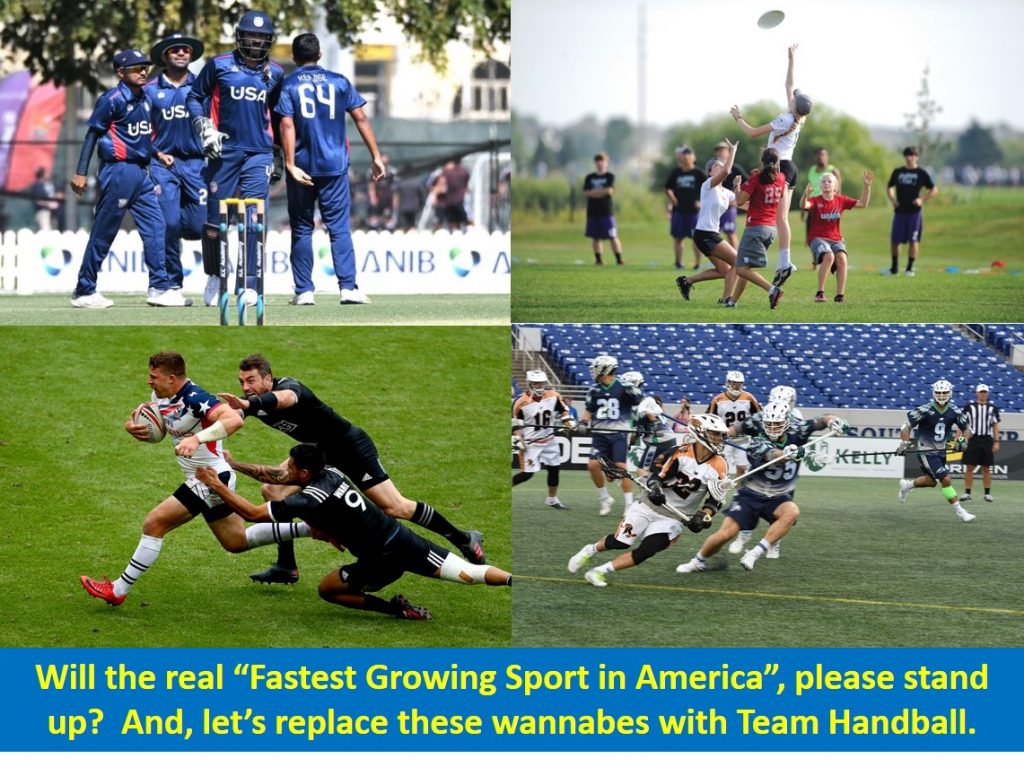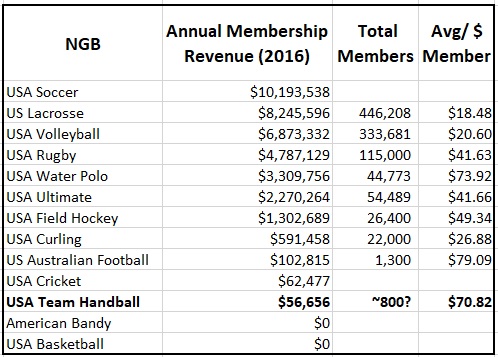
This is part of an ongoing series: Link
Membership: Arguably, the Most Important Metric for a National Governing Body (NGB)
A National Governing Body (NGB) in the sporting world serves many purposes, but serving its members is probably its most important function. One just has to look at the USA Team Handball By-Laws and the 275 times that members or membership is mentioned to get a clear picture as to how important members are.
Aside from By-Law references and common sense, membership is also a major revenue source. Or, ideally it should be. For many NGBs it clearly is. This table highlights the membership revenue for several team sport NGBs using data from their 2016 IRS Form 990s and Annual Reports

As can be readily seen USA Team Handball revenue, as well as, total members is significantly smaller than most other team sport NGBs. Orders of magnitude smaller.
Additionally, while membership has its own dedicated revenue line it also indirectly impacts every other line to a significant extent. If an NGB wants to bring in more revenue for events and clinics then doing so will be greatly enhanced by a larger membership. And, it goes without saying that activating sponsorships for a membership base that doesn’t crack a 1,000 can be a pretty tough sell.
But, if you increase membership revenue and the total numbers of members everything becomes a bit easier. Convincing would be sponsors becomes easier. Convincing a TV network to air handball matches becomes easier… which also makes selling sponsorship easier.
The Fuzzy Math Behind NGB Membership
The importance of a large membership base is therefore very clear. Or, if it’s not large, it’s good to be showing some real growth from year to year. Make no mistake: This is a reality not lost on NGBs. Yes, amusingly, multiple sports have at different points in the recent past or present have laid claim to the title, “Fastest growing sport in the U.S.” And, since data is sketchy and can be manipulated they all probably can make the claim without being called out. Heck, depending on how growth is defined/calculated from time period to time period they all could be right.
If an NGB wants to increase membership there are steps that can be taken. To a certain extent membership can be boosted by lowering the cost. Or, it can be boosted by making a huge push via reduced cost youth memberships. Or, memberships can be tied to directly to participation in high interest competitions. Because of these potential step it’s important to look at membership revenue in addition to the total membership. But, as I’ve learned recently even membership revenue can be manipulated to an extent by making membership revenue to the NGB a “pass through” revenue that is mostly distributed back to regional bodies. (or, in the case of USA Rugby, was supposed to have been distributed back to regional bodies.)
Tracking Membership and Officially Taking the Mantle of Fastest Growing Sport
So, what is USA Team Handball’s membership total? I hate to say this, but I really don’t know. I’m not even sure if USA Team Handball knows. I have asked this question multiple times in the past and have never gotten a definitive straight answer. Instead I’ve usually been given a deflected answer with maybe a low and high range value. Over the years I’ve heard numbers as low as 300 and as high as 1,200. I think there are a couple of reasons for this.
Firstly, I don’t think USA Team Handball has ever had a decent system for tracking this number. Either back in the old days when membership was handled by check or more recently with the Top Score management system that is now being replaced. On top of that, the number of members changes depending on the time of the year. So, if you ask for the number early in the yearly cycle it’s going to be lower since a lot of people don’t sign up until… well, until they have to. Old timers might well remember the long membership sign up line at the National Championships. As in, you couldn’t play if you weren’t a member. And, if USA Team Handball picked a bad location for nationals and fewer people showed up I bet the membership suffered that year.
Still despite these handicaps, it’s not rocket science. There should be a yearly official membership number, but, believe it or not, I don’t recall ever seeing it written down in official documentation. As someone who likes crunching and assessing data you can probably guess what I think about that.
Of course, that’s all in the past. It’s a new day and we’ve got a new membership platform (Sport:80) Whatever the membership number is we can bet that it’s being closely tracked now. It’s surely a low number and while we could whine about it being such a low number, we can also look at it as a crazy good opportunity to show improvement. Because with better revenue flows and the IHF grant to support college development, it’s hard to imagine not improving upon it significantly. And, when you’re starting with a small number percentage growth can be really impressive. For instance, if our current membership is let’s say 800 and we were to simply add 400 members next year we would have a 50% growth rate. A growth rate that would be nearly impossible for sports like Ultimate, Cricket, Rugby and Lacrosse to match.
And, USA Team Handball shouldn’t just track the top level number, but track membership data by age, region and club. And, then track that data from year to year. To see where members are being gained, lost and retained. This data is “gold” and it can really show what’s working and not working in terms of development efforts.
I suppose I’m getting a bit ahead of myself. That I’m eyeing some end goals in terms of membership and, in turn, the number of clubs in the U.S. But, then again it’s hard to set such goals if one doesn’t first fully understand what one has to begin with.
And, I’m getting a bit tired of the drudgery associated with capturing “What We Have”. Why, believe it or not, some folks have even accused me of not being forward thinking and stuck in the past. As if? Everybody knows it’s more fun to dream up solutions. And, far less fun to do the homework.
I’ve done a lot of homework. Not that I probably won’t backtrack some, but it’s time to start delving into the “What We Want” portion of this effort.